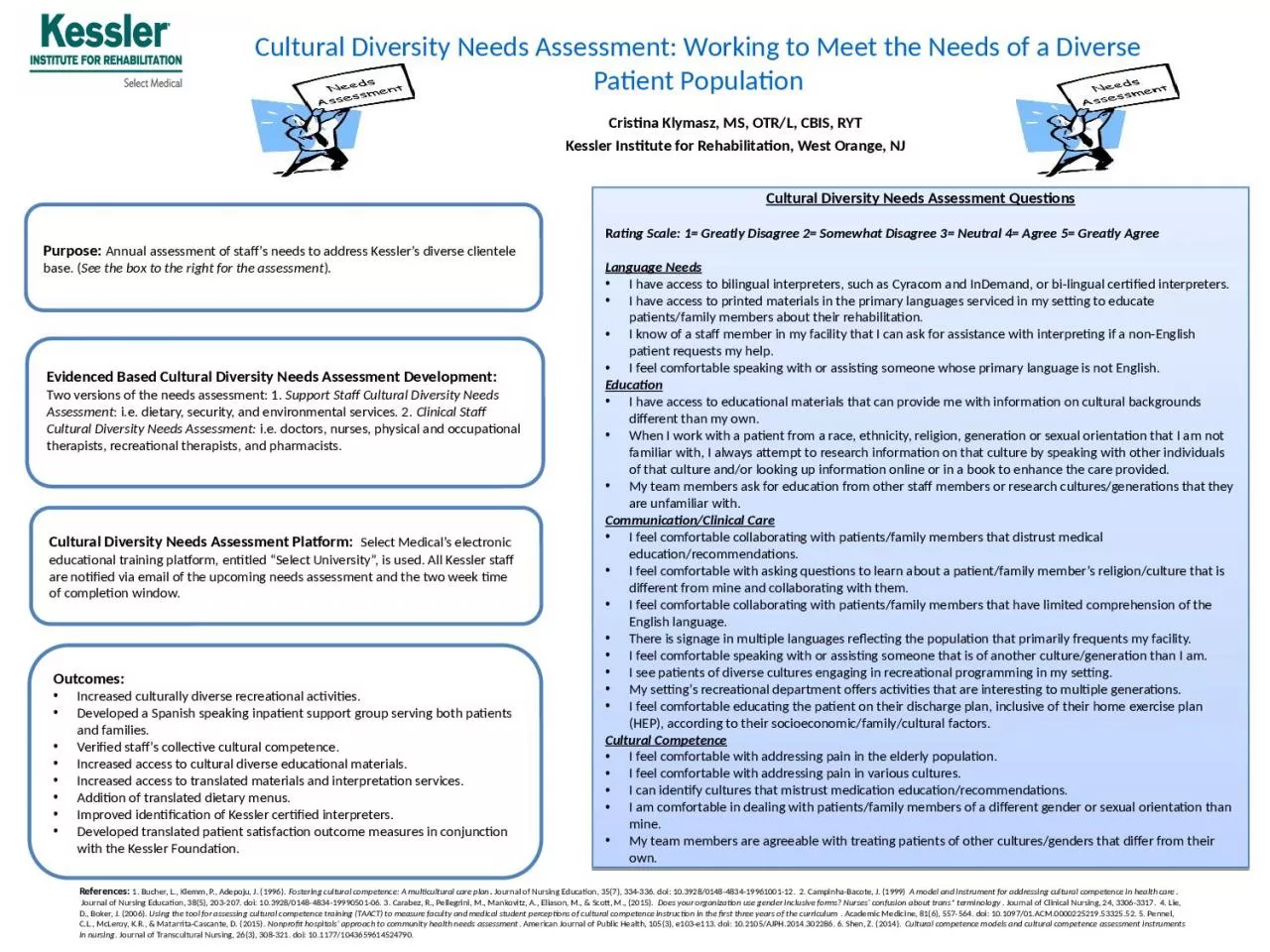

Cristina Klymasz MS OTRL CBIS RYT Kessler Institute for Rehabilitation West Orange NJ Purpose Annual assessment of staffs needs to address Kesslers diverse clientele base See the box to the right for the assessment ID: 930241
Download Presentation The PPT/PDF document "Cultural Diversity Needs Assessment: Wor..." is the property of its rightful owner. Permission is granted to download and print the materials on this web site for personal, non-commercial use only, and to display it on your personal computer provided you do not modify the materials and that you retain all copyright notices contained in the materials. By downloading content from our website, you accept the terms of this agreement.
Slide1
Cultural Diversity Needs Assessment: Working to Meet the Needs of a Diverse Patient Population
Cristina Klymasz, MS, OTR/L, CBIS, RYTKessler Institute for Rehabilitation, West Orange, NJ
Purpose:
Annual assessment of staff’s needs to address Kessler’s diverse clientele base. (See the box to the right for the assessment).
Evidenced Based Cultural Diversity Needs Assessment Development: Two versions of the needs assessment: 1. Support Staff Cultural Diversity Needs Assessment: i.e. dietary, security, and environmental services. 2. Clinical Staff Cultural Diversity Needs Assessment: i.e. doctors, nurses, physical and occupational therapists, recreational therapists, and pharmacists.
Cultural Diversity Needs Assessment Platform: Select Medical’s electronic educational training platform, entitled “Select University”, is used. All Kessler staff are notified via email of the upcoming needs assessment and the two week time of completion window.
References: 1. Bucher, L., Klemm, P., Adepoju, J. (1996). Fostering cultural competence: A multicultural care plan. Journal of Nursing Education, 35(7), 334-336. doi: 10.3928/0148-4834-19961001-12. 2. Campinha-Bacote, J. (1999) A model and instrument for addressing cultural competence in health care. Journal of Nursing Education, 38(5), 203-207. doi: 10.3928/0148-4834-19990501-06. 3. Carabez, R., Pellegrini, M., Mankovitz, A., Eliason, M., & Scott, M., (2015). Does your organization use gender inclusive forms? Nurses’ confusion about trans* terminology. Journal of Clinical Nursing, 24, 3306-3317. 4. Lie, D., Boker, J. (2006). Using the tool for assessing cultural competence training (TAACT) to measure faculty and medical student perceptions of cultural competence instruction in the first three years of the curriculum. Academic Medicine, 81(6), 557-564. doi: 10.1097/01.ACM.0000225219.53325.52. 5. Pennel, C.L., McLeroy, K.R., & Matarrita-Cascante, D. (2015). Nonprofit hospitals’ approach to community health needs assessment. American Journal of Public Health, 105(3), e103-e113. doi: 10.2105/AJPH.2014.302286. 6. Shen, Z. (2014). Cultural competence models and cultural competence assessment instruments in nursing. Journal of Transcultural Nursing, 26(3), 308-321. doi: 10.1177/1043659614524790.
Outcomes: Increased culturally diverse recreational activities. Developed a Spanish speaking inpatient support group serving both patients and families. Verified staff’s collective cultural competence.Increased access to cultural diverse educational materials.Increased access to translated materials and interpretation services.Addition of translated dietary menus. Improved identification of Kessler certified interpreters. Developed translated patient satisfaction outcome measures in conjunction with the Kessler Foundation.
Cultural Diversity Needs Assessment QuestionsRating Scale: 1= Greatly Disagree 2= Somewhat Disagree 3= Neutral 4= Agree 5= Greatly AgreeLanguage NeedsI have access to bilingual interpreters, such as Cyracom and InDemand, or bi-lingual certified interpreters.I have access to printed materials in the primary languages serviced in my setting to educate patients/family members about their rehabilitation.I know of a staff member in my facility that I can ask for assistance with interpreting if a non-English patient requests my help. I feel comfortable speaking with or assisting someone whose primary language is not English. EducationI have access to educational materials that can provide me with information on cultural backgrounds different than my own.When I work with a patient from a race, ethnicity, religion, generation or sexual orientation that I am not familiar with, I always attempt to research information on that culture by speaking with other individuals of that culture and/or looking up information online or in a book to enhance the care provided. My team members ask for education from other staff members or research cultures/generations that they are unfamiliar with. Communication/Clinical CareI feel comfortable collaborating with patients/family members that distrust medical education/recommendations. I feel comfortable with asking questions to learn about a patient/family member’s religion/culture that is different from mine and collaborating with them.I feel comfortable collaborating with patients/family members that have limited comprehension of the English language. There is signage in multiple languages reflecting the population that primarily frequents my facility.I feel comfortable speaking with or assisting someone that is of another culture/generation than I am.I see patients of diverse cultures engaging in recreational programming in my setting. My setting’s recreational department offers activities that are interesting to multiple generations. I feel comfortable educating the patient on their discharge plan, inclusive of their home exercise plan (HEP), according to their socioeconomic/family/cultural factors. Cultural CompetenceI feel comfortable with addressing pain in the elderly population. I feel comfortable with addressing pain in various cultures. I can identify cultures that mistrust medication education/recommendations.I am comfortable in dealing with patients/family members of a different gender or sexual orientation than mine. My team members are agreeable with treating patients of other cultures/genders that differ from their own.